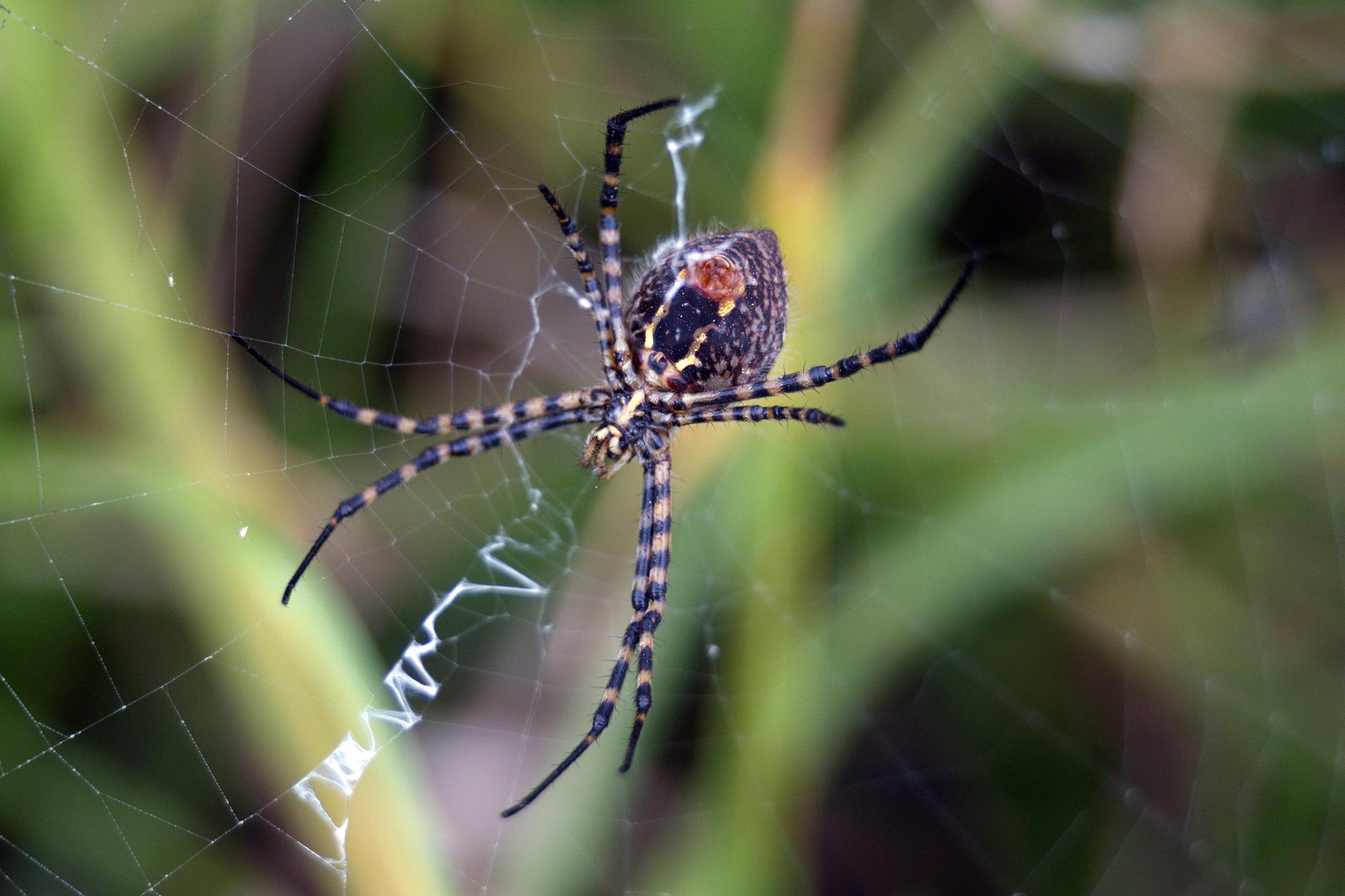
Bilim adamları, Cermen dokuma örümceğinin ağ yapıştırıcısının özelliklerinin, türün yaşam ortamına bağlı olarak geliştiğini keşfettiler. çalışarak argiope argentata Ve Argiope trifasciata Araştırmacılar, sırasıyla kuru ve ıslak ortamlarda yaşayan türler arasında, ağ yapıştırıcısının benzer proteinlerden oluşmasına rağmen, oranların farklı olduğunu ve yapıştırıcının özelliklerini etkilediğini buldular. Tutkalın atmosferdeki suyu emme ve bağlama yeteneği, örümceklerin hayatta kalması için çok önemlidir ve bu uyarlamaları anlamak, endüstride, tıpta ve daha fazlasında potansiyel uygulamalara sahip olabilir.
Çok farklı ortamlardan orb weaver örümceklerinin genleri benzerdir, ancak yapışkan proteinler ve müsilaj özellikleri, diferansiyel gen ekspresyonu nedeniyle büyük ölçüde farklılık gösterir.
Ballweaver örümcekleri, özel toplama bezlerinde yapılan su bazlı bir yapıştırıcı ile ağlarının yakalama ipliklerini yapışkan hale getirir. Bilim adamları farklı çalıştı[{” attribute=””>species living in different environments to see how the glue changed and found that although the glue was mostly made of the same components, the proportions of the proteins involved were different, changing the glue’s properties.
Spiders that don’t weave good silk don’t get to eat. The silk spiders produce which creates their webs is key to their survival – but spiders live in many different places which require webs fine-tuned for local success. Scientists studied the glue that makes orb weaver spiders’ webs sticky to understand how its material properties vary in different conditions.
“Discovering the sticky protein components of biological glues opens the doors to determining how material properties evolve,” said Dr Nadia Ayoub of Washington and Lee University, co-corresponding author of the study published in Frontiers in Ecology and Evolution. “Spider silk fibers and glues represent a fantastic model for answering such questions since they are primarily made of proteins and proteins are encoded by genes.”
“Spider silks and glues have huge biomimetic potential,” added Dr Brent Opell of Virginia Tech, co-corresponding author. “Spiders make glues with impressive properties that would have applications in industry, medicine, and beyond.”
Tangled up in spider webs
Each strand of an orb weaver spider’s web contributes to the capture of food. The web has a stiff frame which absorbs the impact of prey, which are then trapped by sticky lines until the spider can tackle them. These lines are made sticky by an aqueous glue synthesized in aggregate glands. The glue absorbs water from the atmosphere and needs to be optimized to achieve the best stickiness results for the local humidity. But there are many species of orb weaver spider living in different environments, which means their glue must adapt to different levels of humidity.
To understand how spider glue stickiness adapts, Ayoub and her colleagues focused on two species, Argiope argentata — which lives in dry environments — and Argiope trifasciata, which lives in humid environments. The team collected webs from A. trifasciata in the wild and had A. argentata spiders build webs in the lab. To ensure that these webs were equivalent to webs in the wild, the scientists fed the spiders a diet comparable to their usual prey and compared glue droplet volume to wild controls to make sure that the humidity in the lab wasn’t affecting the droplets’ properties. They then analyzed the proteins in the glue and the droplets’ material properties.
A sticky situation
The team found that droplets from A. argentata spiders are smaller than those from A. trifasciata and absorb less water as local humidity increases. They also had smaller protein cores, occupying a smaller proportion of the droplet’s volume, and absorbed less water from the atmosphere. The toughness of glue droplets for both species of spider is based on the stiffness of the protein core of the droplets, and A. argentata protein core toughness decreased as the humidity went up. A. argentata thread glue droplets were generally more closely spaced and stickier.
The scientists also analyzed the proteins found in the glue droplets to understand how these differences in material properties arise from the proteins. Although the proteins they found were similar, they appeared in different proportions, and A. argentata glue contained the protein products of four genes that didn’t appear in A. trifasciata glue. These extra proteins and a more balanced ratio of AgSp1 and AgSp2 proteins may explain both the greater toughness of this glue and its lower capacity for water absorption.
“Despite the dramatic differences in material properties, the two species share most of their protein components,” said Opell. “The sequences of these proteins are also similar between species, but the relative abundance of individual proteins differs. Modifying the ratios of proteins is likely a rapid mechanism to adjust material properties of biological glues.”
“This study only examined two species, so our proposed relationships between proteins and material properties are limited,” cautioned Ayoub. “However, we are in the process of documenting protein components and material properties of a diverse set of species, which will allow more power to detect the mechanisms of how proteins give rise to material properties.”
Reference: “Orb weaver aggregate glue protein composition as a mechanism for rapid evolution of material properties” by Nadia A. Ayoub, Lucas DuMez, Cooper Lazo, Maria Luzaran, Jamal Magoti, Sarah A. Morris, Richard H. Baker, Thomas Clarke, Sandra M. Correa-Garhwal, Cheryl Y. Hayashi, Kyle Friend and Brent D. Opell, 18 April 2023, Frontiers in Ecology and Evolution.
DOI: 10.3389/fevo.2023.1099481
Funding: National Science Foundation, National Science Foundation, National Science Foundation, Washington and Lee University

“Analist. Tutkulu zombi gurusu. Twitter uygulayıcısı. İnternet fanatiği. Dost pastırma hayranı.”




More Stories
hızlı! Birisi bu doktor kitabını alsın.
Antik kazılar bilinen en büyük deniz sürüngenlerinin keşfedilmesine yol açtı
Cape'teki Starlink Falcon 9 lansmanından canlı güncellemeler